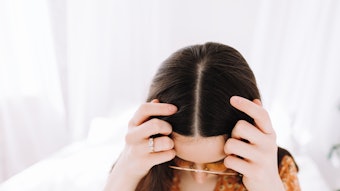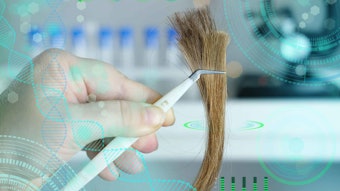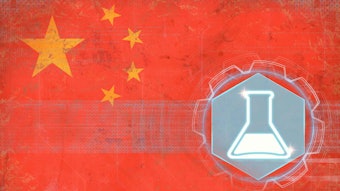
Hair’s durable structure is under constant bombardment from a variety of onslaughts. These include mechanical insults such as grooming and braiding; chemical treatments, e.g., perms, relaxers, permanent coloring; exposure to high heat from hair dryers and styling tools; and environmental effects including sun exposure. Each of these insults takes its toll on the hair by a specific means—and yet the outcome of these diverse effects, either individually or cumulatively, is described in our industry as one, all-encompassing and simple word damage. I am frequently asked, “how damaged is that hair?” or “how can I repair damage?” But clearly, damage is not one specific entity and these seemingly simple questions have far more complex answers.
Log in to view the full article
Hair’s durable structure is under constant bombardment from a variety of onslaughts. These include mechanical insults such as grooming and braiding; chemical treatments, e.g., perms, relaxers, permanent coloring; exposure to high heat from hair dryers and styling tools; and environmental effects including sun exposure. Each of these insults takes its toll on the hair by a specific means—and yet the outcome of these diverse effects, either individually or cumulatively, is described in our industry as one, all-encompassing and simple word damage. I am frequently asked, “how damaged is that hair?” or “how can I repair damage?” But clearly, damage is not one specific entity and these seemingly simple questions have far more complex answers.
A first step in distinguishing between the different forms of hair damage might be to specify where these actions manifest. To this point, the first article1 in this series specifically discussed damage to hair’s surface cuticle structure and showed how this breakdown will impact tactile properties, manageability and shine. This second article now focuses on changes to the internal cortex structure, which is responsible for hair’s mechanical properties such as strength, stiffness, etc.
Unlike the outer cuticle structure, this inner sanctum is not readily viewable and we must rely on secondary measures to examine its integrity. This adds additional complexity since different measurement approaches specifically probe-select regions of the complex hierarchical structure. Therefore, assessment of internal hair damage becomes a more holistic endeavor. The combination of different instrumental techniques and experiments performed under varying conditions will lead to a most comprehensive indication of how the internal structure is changed by treatments and practices.
As an aside, this series on hair damage originally was envisaged in two parts: outer and inner damage. However, the complexity of this topic justifies its expansion to a trilogy. This second installment specifically focuses on using mechanical properties to probe the inner structure of hair. (see Part I and Part III)
The Cortex Structure
It is first necessary to review the cortex structure. The inside of hair consists of longitudinal cortical cells or macrofibrils that are embedded in a lipid-like cell membrane complex. These macrofibrils further consist of smaller units, sometimes termed microfibrils or more commonly, intermediate filaments (IFs), which themselves are comprised of ordered, crystalline, alpha-helical keratin protein. These pack together with an amorphous keratin matrix phase known as keratin associated protein (KAP).
The importance of these two protein forms, i.e., crystalline or amorphous, relates to the manner with which they interact with water. Water is able to readily penetrate into amorphous materials while crystalline microfibrils are impenetrable. This represents the origin of differing hair properties in the wet and dry states. Incursion of water into the matrix allows for solvation of electrostatic bonding within the protein—with commensurate plasticization and swelling of this structure. In short, dry state mechanical properties of hair are the result of contributions from both the microfibrils and the matrix but when wet, matrix involvement is lost to plasticization and mechanical properties are supported by the microfibrils alone.
In terms of practical consumer-related relevance, this means dry hair is considerably stiffer and stronger than wet hair. But when performing mechanical testing, it means experiments in these two different states probe properties of different structural regions.
Dry state properties of hair are supported by both microfibrils and the matrix. When wet, however, matrix involvement is lost, so hair properties rely on microfibrils alone.
Mechanical Properties as an Indicator of Cortex Damage
The impressive mechanical properties of hair are a consequence of this complex internal architecture; so their measurement represents a probe into this hidden region. Any alteration in mechanical properties must be a consequence of structural changes.
A previous article in this column discussed the use of constant rate extension experiments to generate stress-strain curves for single hair fibers.2 Briefly, individual hair fibers are stretched in a controlled manner and the resulting internal forces are evaluated. An example of an experimental trace from this type of experiment is given in Figure 1. Hair’s tensile properties have considerable dependence on fiber dimensions where, all things being equal, a thick fiber will be stronger than a thin one. Therefore, testing involves first measuring fiber dimensions—such that forces can be normalized into a force-per-unit area or stress.
Figure 1 also shows a selection of parameters that can be extracted from such stress-strain curves—although many others also exist. This curve specifically represents data from a dry state experiment but testing is also commonly performed in the wet state. This further compounds the number of parameters to be considered and results in perhaps the biggest issue with this approach: what parameter (or parameters) should best be used for characterization?
Perhaps the most instinctive gauge of hair strength is represented by the force-to-break or more appropriately, as just described, the break force normalized against fiber dimensions, i.e., the break stress. Most often, the purpose of performing these experiments is to detect and numerically evaluate the effects of various “damaging” treatments. To this end, those who regularly perform such testing recognize that considerably larger differences tend to manifest when performing experiments in a wet state. Accordingly, the vast majority of all tensile data we encounter generally consists of wet-state break stress results.
For example, Figure 2 shows wet state break stress results demonstrating the detrimental effect of progressively stronger bleaching conditions. Previous articles in this column have similarly shown results that illustrate declining wet state tensile properties as a function of thermal treatments3 and artificial sun exposure.4
In relation, Figure 3 shows wet state break extension results for these same bleached hair samples. Maybe somewhat counter intuitively, results show how treated fibers can be extended to significantly greater lengths before breakage occurs. This more-plasticized state is readily observable by simple handling and tugging treated fibers.
In contrast, Figure 4 shows wet state break extension results for hair that received increasing levels of heat damage via progressively higher numbers of passes with a commercial straightening iron. In this instance, the break extension decreases as a result of this insult.
In short, while the wet state break stress is the most commonly used measure of mechanical damage, it should not be the only factor we consider. These two insults likely induce similarly diminished break stress results, but the polar opposite trends in the way the break extension responds to chemical and thermal treatments suggests the internal structure is being changed in different ways.
More on Dry vs. Wet State Testing
These two states clearly represent extremes with a spectrum of conditions existing between them. A previous article in this column5 discussed how the water content of hair is implicitly linked to the RH of the surrounding environment, wherein higher moisture levels exist at elevated RH. The mechanical properties of hair will, therefore, also vary in a predictable manner with climatic conditions.
By means of illustration, Figure 5 shows results for the Young’s modulus, i.e., the tensile stiffness, of virgin and chemically damaged hair as a function of RH. As discussed, the modulus declines with increasing RH due to higher fiber moisture content.
Results in Figure 5 were generated by a modified version of the traditional stress-strain approach. The modulus is the slope of the initial part of the stress-strain curve (see Figure 1). Its evaluation therefore does not require fibers to be extended out to their break point. In this instance, fibers were exposed to only a 5% deformation and their initial properties could be reset by allowing structural relaxation at elevated humidity. In this way, measurements at each humidity condition can be performed on the exact same set of 50 replicate hair fibers. While these experiments take considerably longer to perform, notable benefits ensure. A markedly lower standard deviation arises by testing the same set of individual fibers. Also, higher confidence in conclusions results from the examination of trends in systematic experiments, rather than considering any one data point.
For example, clear differences are seen between the shapes of these curves for healthy and bleach-damaged hair (see Figure 5). Oxidative chemical treatments are known to deplete strength-supporting cystine disulfide bonds in hair—and so we would expect tensile properties to decline. This outcome is indeed observed when the fibers possess relatively high water content but the modulus is seen to increase when the fiber’s water content is lower.
This graph is a cause of some concern to analysts, as it indicates different outcomes may transpire under different conditions. A scientist performing experiments in the wet state would discover that bleaching softens fibers; while another conducting dry state testing (at medium or low humidity) would reach the opposite conclusion. Further, a third analyst who, by chance, conducted the same experiment at 80% RH, would conclude that no structural change had occurred. Clearly, the comparison of mechanical properties at any single humidity condition represents just one snapshot of a much bigger picture.
Other Mechanical Testing Approaches
The described results show how different outcomes can result from performing the same test under different conditions. It should not necessarily be a surprise, therefore, to discover different mechanical tests can also yield different conclusions. For example, a previous article in this column described measuring the tendency for hair fibers to break under the repeated application of smaller fatiguing forces.6 This approach seemingly represents a better simulation of the mechanical insults encountered by fibers during everyday grooming.
The article described how data is typically expressed as S-N Curves—where the number of repeated cycles for breakage (N) is plotted against the magnitude of the repeating stress (S). Figure 6 shows S-N Curves for virgin Caucasian and African hair that were generated at 60% RH. As anticipated, results show African hair breaking after application of considerably fewer fatiguing repetitions, but it is the magnitude of this difference that is noteworthy. Traditional stress-strain testing on these same hair types, under comparable environmental conditions, shows African hair having a dry state break stress that is approximately 13% lower that Caucasian hair. However, fatigue testing suggests an approximate ten-fold decrease in fatiguing cycles-to-fail.
This is a consistent observation when comparing results from these two techniques: fatigue testing almost always suggests considerably larger and more worrisome tendencies for breakage. It is entirely possible, therefore, that our long-standing reliance on the stress-strain approach has led to a sizable underestimation of the contribution of various insults to hair breakage.
Chemical oxidation and photo-chemical oxidation appear to affect the hair protein in different ways.
So why should these two techniques produce different results? Constant rate extension experiments measure the intrinsic tensile properties of the hair fibers—yet, when it comes to breakage, a material will always fail at its weakest point. The presence of any flaw, blemish or imperfection represents a point of weakness that can be propagated by repeated action of an external stimulus considerably lower than the break stress. In short, fatigue testing results are dependent on the presence and a propagation rate of flaws, while conventional tensile testing results relate to the inherent fiber structure. Comparing and contrasting hair breakage results from these two approaches therefore suggests a new theory for conceptualizing factors that lead to hair breakage.7
Summary
The internal cortex structure of hair is not easily visible—and so, changes in readily measurable parameters are used as a proxy for structural alteration. The most commonly used method is a constant extension rate experiment to probe hair’s fundamental tensile properties.
These experiments are easy to perform, especially given the availability of commercially available automated tensile testers, which also aid in running a suitably high number of replicate samples to provide appropriate statistical rigor. This said, experiments do not spit out a single characterization parameter. In fact, the data analysis software associated with the commercial instrumentation calculates 18 different parameters from each stress-strain curve.
Further compounding this issue, hair’s mechanical parameters are highly dependent on moisture level and will change systematically with the RH or immersion in water. The question then becomes, “Which parameters should I consider, and under what conditions?”
Wet state break stress results are, by far, the most commonly used in attempt to quantify internal hair damage and these can be used to demonstrate the deleterious effects of known hair insults. Yet, this article makes the case that further insight can be gained from consideration of other parameters.
For example, oxidative chemical treatments lead to an increase in the break extension for hair, while heat damage decreases this parameter. It must therefore be concluded that these two insults affect the internal hair structure in different ways. This might not be especially surprising given the different nature of the insults. However, in a similar vein, tensile experiments on hair exposed to artificial accelerated weathering conditions also result in progressively lower break extensions. In short, chemical oxidation and photo-chemical oxidation appear to be affecting the hair protein in different ways.
Similarly, results were shown that illustrate how very different conclusions can arise as a consequence of performing these experiments under different environmental conditions. For example, heat treatment and many forms of chemical treatment can increase fiber stiffness under most dry-state conditions, while lowering this parameter in the wet state and at elevated humidity.
These differences occur because different regions of the stress-strain curves and different environmental conditions probe different areas of the hair fiber structure. The same can be true for other mechanical testing approaches where, for example, fatigue experiments often suggest alarmingly higher tendencies for fiber breakage than corresponding stress-strain experiments.
It is hoped that the first two parts of this series has emphasized how damage is not a single entity; the complex structure of hair can be altered in so many ways and with subsequent impact on both single fibers and fiber array properties. I would therefore like to instigate a movement whereby hair scientists, at least when talking to each another, abandon the D word and instead introduce language that more specifically, and scientifically, describes alterations in hair structure and properties. This will be the topic of the third and final part of this series.
References
- TA Evans, How damaged is hair? Part 1: Surface damage, Cosm & Toil 132(4) 38-48 (Apr 2017)
- TA Evans, Measuring hair strength, part 1: Stress-strain curves, Cosm & Toil 128(8) 590-594 (2013)
- TA Evans, Beating the damaging effects of heat on hair, Cosm & Toil 130(5) 28-33 (Jun 2015)
- TA Evans, The effects of sun on hair, Cosm & Toil 131(7) 46-52 (2016)
- TA Evans, Measuring the water content of hair, Cosm & Toil 129(2) 64-69 (2014)
- TA Evans, Measuring hair strength, part 2: Fiber breakage, Cosm & Toil 128(12) 854-859 (2013)
- TA Evans, A unifying theory for visualizing the causes of hair breakage and subsequent strategies for mitigation, J Cos Sci 68 137-140 (2017)










